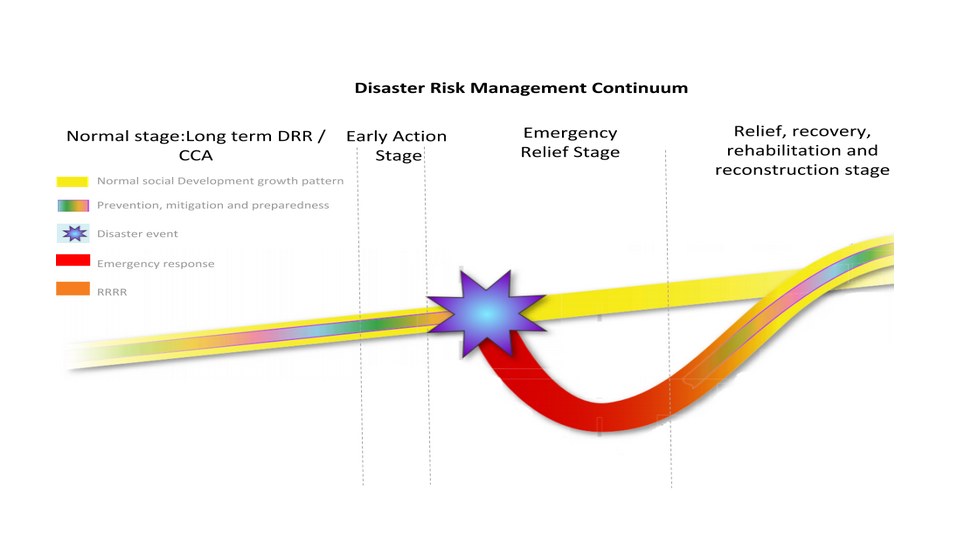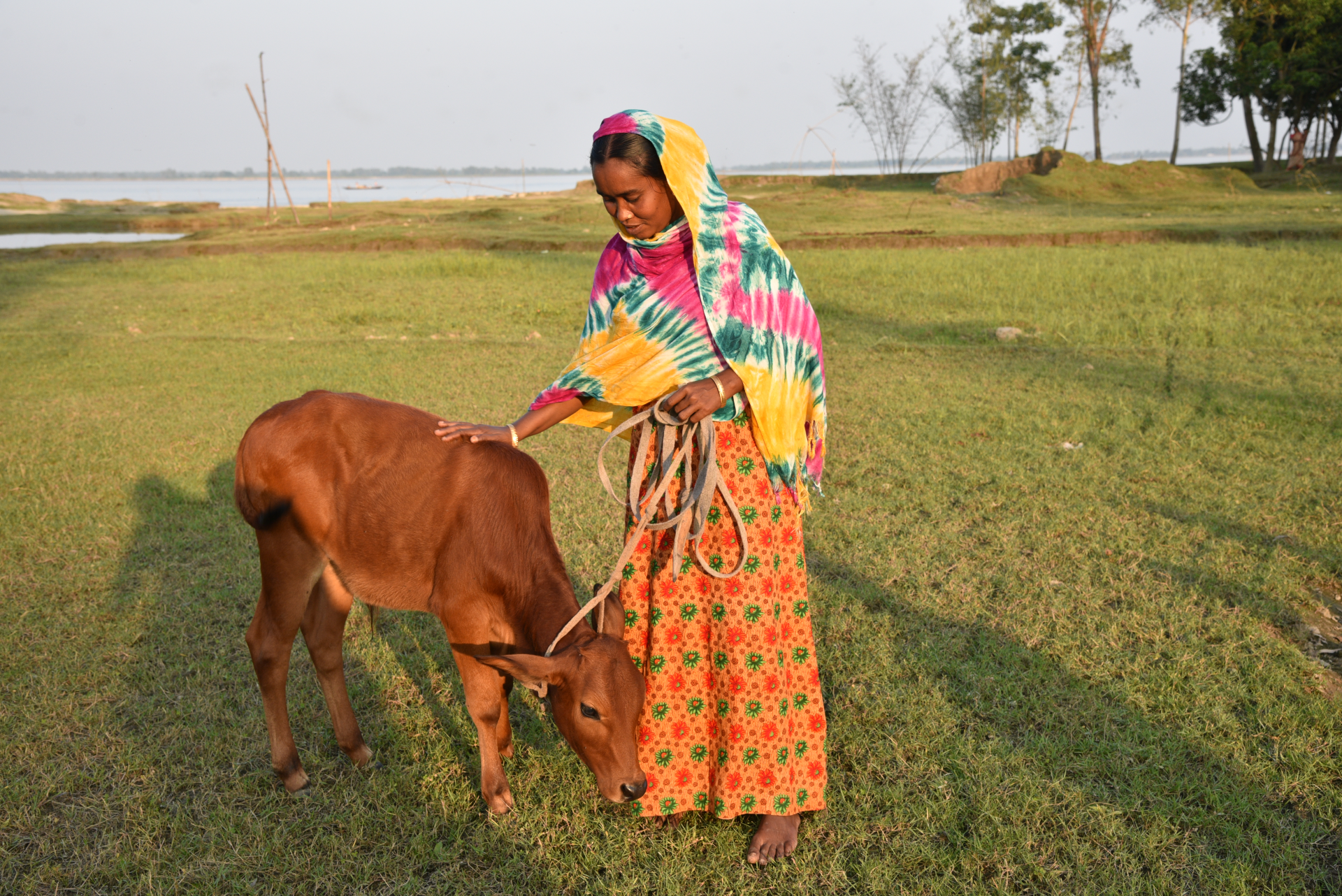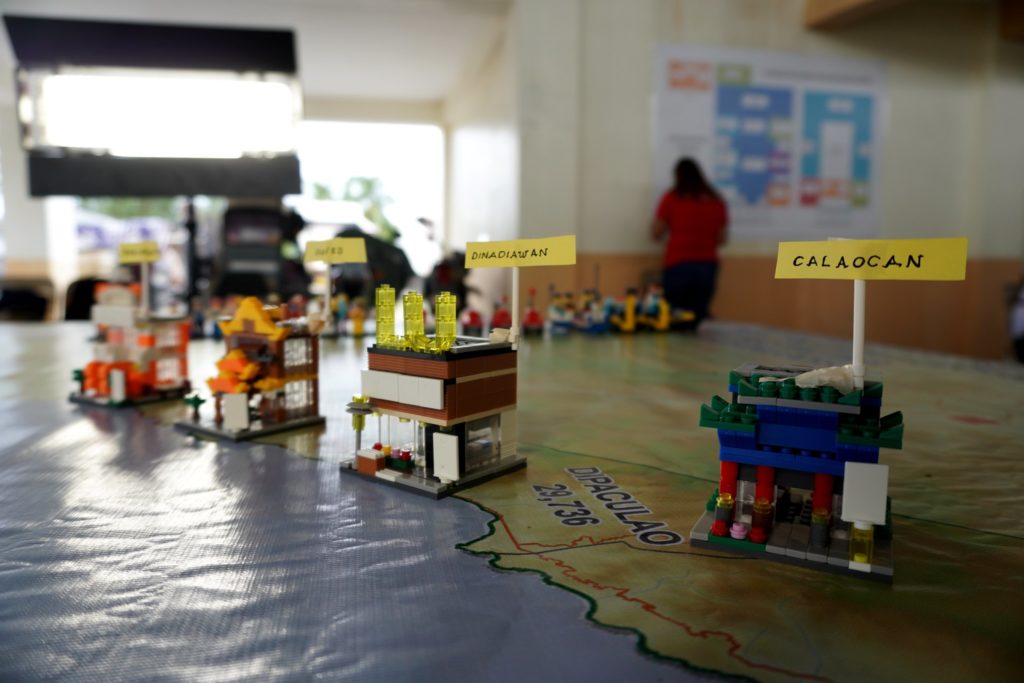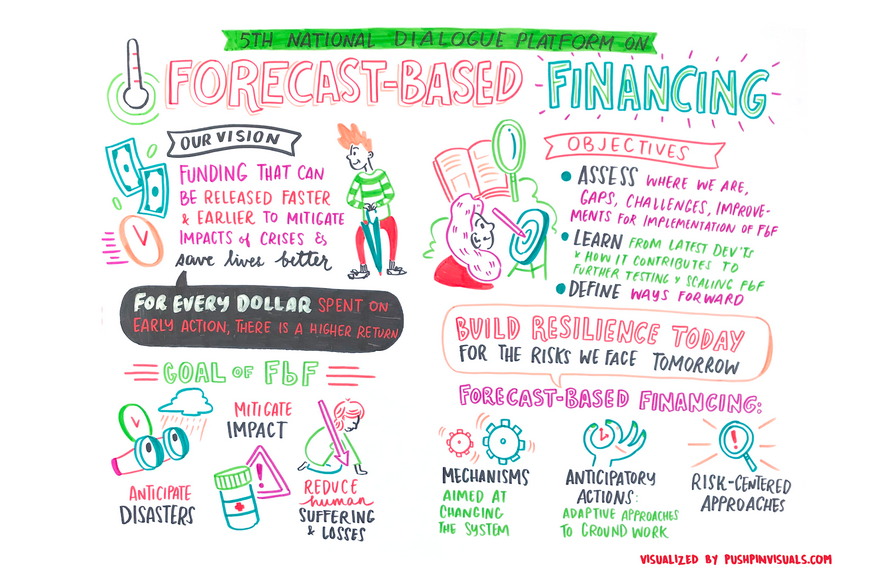Summary
Advocacy and communication are integral to forging well-balanced partnerships with clear and reciprocal responsibilities between respective governments and National Societies. As with many RCRC projects and programs, advocacy is a central tool to reach decision-makers, donors and policy makers. As pioneering practitioners of FbF, National Societies are well positioned to lead FbF advocacy efforts, and design FbF programs tailored to national and subnational DRM contexts in close collaboration with government agencies and other stakeholder.
Government plays a critical role in the creation of a conducive environment for FbF through policy formulation, technical expertise, data and provision of resources necessary for the set up and implementation early actions, the improvement of weather services, sharing of risk data and the creation of enabling environments for cooperation across multiple sectors.
As auxiliaries to the government, National Societies depend on governments to lay the conducive Disaster Risk Management environment to carry out their services, while governments rely on National Societies to provide robust support, filling gaps across preparedness and response needs.
In many countries, the activation of EAPs and implementation of early actions once an extreme event it forecast, depend on government authorization and validation of these actions. It is therefore critical that government authorities from the local to national levels be engaged in the implementation of the FbF program and the development of the National Society’s EAP.
Beyond the involvement of government in the development and implementation of RC/RC EAPs, advocacy with governments is also crucial for efforts towards scaling up FbF and making it last. The integration of FbF or similar approaches into national DRM systems is the best way to ensure sustainability of FbF at national level and the coverage needed to reach large parts of the population at risk. Advocacy with governments on FbF in most projects follows this longer-term objective, and interesting progress has been made in this direction in some countries such as the Philippines. Governments have the mandate and duty to protect their citizens from the impacts of disasters through climate change adaptation, disaster risk reduction, preparedness, emergency response and recovery. The Sendai Framework of Action, Sustainable Development Goals and the Paris Agreement, offer the political frameworks and are an opportunity to advocate for the integration of FbF into government DRM structures, especially as many governments are currently revising their laws to be in line with these frameworks.
During the last years, humanitarian and development partners/ donors have scaled up their support and engagement in Forecast-based Financing, which can provide further incentives to governments to engage. The creation of the Anticipation Hub, the Risk Informed Early Action Partnership (REAP) and the Early Action Focus Task Force, as well as initiatives such as the WMO Climate Risk Early Warning Systems (CREWS) can support governments by facilitating investments, exchange of learning and experiences and providing technical advice.
Especially in countries where several stakeholders (NGOs, UN, RC) are implementing FbF or similar anticipatory approaches, government can also have an important coordinating role. Vice-versa it is of high importance that efforts to engage government in FbF or anticipation are coordinated among the different FbF implementers and it is ensured that key messages align.
This chapter provides guidance on how to engage relevant government institutions in the development of the FbF system. It is important to note that the steps suggested below are not implemented in a linear order and depending on context, some may be applied simultaneously. There is no “one size fits all approach” to engaging with government. The list below includes common steps strong National Societies have taken to commit, mobilize and engage government in support of FbF Programming. Each National Society knows their context best and as such, should tailor these steps accordingly.
Step 2: Engage government in feasibility study and disseminate findings
Including government in the feasibility study is integral to identifying current and planned policies, government priorities, the state of early warning systems, as well as existing initiatives. This also provides important insights into the capacity of the relevant government agencies to contribute to the development of FbF in-country.
Combining the feasibility study with an introduction to FbF is also an opportunity to mobilize relevant authorities (e.g. Disaster Risk Management, National Hydromet Services (NHMS)) and explain how FbF can fill the gaps between preparedness and response.
Once completed, the Feasibility Study should be presented to government, pointing to complementary policies, programs and plans, gaps and opportunities and ideally a roadmap for next steps for FbF.
Using evidence to strengthen national EWS system with FbF
The results of the feasibility study conducted in Uganda were presented to government authorities at the national level to validate and agree upon next implementation steps. This was important as the subsequent dialogues with the Office of the Prime Minister always made reference to the feasibility study findings. In particular, the study made reference to Uganda’s lack of a national EWS system, as well as flood forecasting model. This was used as a point of entry to engage government in the establishment and integration of FbF into the national emergency and coordination center.
How to best engage government?
“This depends on your National Society context, which you know best. In Uganda and Malawi, we held various breakfast meetings, each with a particular agenda for each session.”
Irene Amuron, Technical Adviser, Red Cross Red Crescent Climate Centre
In order to create government interest and to ensure long-term engagement, it is crucial that key actors are convinced of the approach. There are different approaches to making the case for FbF as listed below, which can be used depending on the context. It is important to strike the right balance between creating “excitement” for the new and innovative approach while not creating expectations it cannot meet.
Promote FbF as complementary to existing EWEA and DRR work
One way to make the case for FbF is to highlight how it FbF can complement and fortify the existing Disaster Risk Management framework. FbF should fold into existing efforts rather than lead to a set up parallel initiatives.
With the enthusiasm around FbF as the “new innovative solution”, some governments might be concerned that it undermines their existing work in DRR and EWEA. Communications should be clear that FbF does not replace DRR; long term disaster risk reduction is pivotal to reduce risks, protect and adapt. However, there are, unfortunately, still many communities where DRR has not been implemented yet or only partially so, and not all risks will be reduced by long term prevention and mitigation measures, therefore FbF is critical to manage the residual risks. It is important to manage expectations of the role FbF can play. Furthermore, emphasis should be made on FbF as being part of the Disaster Risk Management framework with clear guidance on where it fits. FbF sits within Early Action stage.
Practical example: Zambia
In Zambia, the Red Cross worked closely with the Disaster Mitigation and Management Unit to identify where and how FbF could complement ongoing activities. Assessing national-level plans not only presented evidence justifying the implementation of FbF, but also presented a compass for action. A review of the Contingency Plan, enabled Red Cross and authorities to identify gaps that could be bridged through FbF. With this, FbF was eventually packaged as a complementary and supporting initiative to the national CP and wider DRM policies. As a result of this cooperation, DMMU now plays a leadership role in the development of FbF in Zambia; and provides an example for a government agency becoming a champion of integration and engagement.
Showcase FbF effectiveness
There are many ways to demonstrate the effectiveness and added value of FbF. Different angles can be used, with the key argument being that FbF can help the government protect its vulnerable population from losses and suffering. Overall, sharing regional experiences from FbF in pilot countries from around the globe has contributed to raising stakeholder interest in FbF.
- Contribution to Government and/or other Institutional Contingency Plans:
Through its consistency with already existing Governmental EWEA, contingency and preparedness plans FbF can not only add value, but also cover gaps of the current disaster preparedness system.
- Potential to prevent/ mitigate mitigate impact and increase preparedness for response:
Highlight evidence that FbF could/ or has reduced losses, morbidity or mortality based on evidence and learnings from other countries, and highlight the potential for the hazards of focus in your country based on the results of the Feasibility Study. As an example for evidence see the study in Bangladesh following the 2017 activation here.
- Scale:
Demonstrate how many additional people could be aided by FbF in addition to ongoing government plans. The bigger the population protected, the most effective the system is. As FbF focuses on the most vulnerable people living in high risk-prone areas, it should be shown how many of them could be protected, thereby reducing the need for government assistance following the disaster.
- Practicality:
Show how FbF pilot project early actions from other FbF countries within your region, or those facing similar hazards have contributed to effective response.
- Value for Money:
Highlight potential economic benefits of early action for the community and government, referring to the relevant publications on this topic.
- Potential for new partnerships:
Point to the local/regional actors working on FbF within the region, who could work in collaboration.
- Appropriate financing options:
Discuss what the FbA by DREF can do, and where traditional humanitarian assistance and available government funds could play a role.
- Promising link to social protection:
Present the potential to link FbF to existing programs, for example, social protection, to increase efficient implementation and high impact.
Show concrete examples of how FbF can help
Combine evidence and experience: “See + Action formula”
The checklist above can be enhanced through combining general evidence from FbF projects with concrete experience from communities. After all, the goal of FbF is to prevent and reduce suffering in people we serve. Who better can speak to the effectiveness of FbF, than those we assist?
The IFRC’s Practical Guide to Advocacy for Disaster Risk Reduction (2009) recommends the “See + Action Formula”.
Practical Example: Bangladesh
Statement:
(Write a simple statement.)
Bangladesh is one of the most disaster-prone countries in the world.
Impact:
(Give an example of humanitarian impact.)
It’s ranked by the Climate Change Vulnerability Index as the country most at risk globally. This is also a result of its geophysical features. Just under 70% of the country is vulnerable to flooding, and cyclones hit coastal areas almost every year. Evacuation can last up to 4 weeks, and farmers or daily laborers; receive little to no income during that period; typically they must sell assets or take up high interest loans to evacuate, plus pay for food, and health expenses during evacuation and after.
Example:
(Use an example or personal story from your own/assisted person’s experience.)
Alefa Katun (40) works as a daily worker on the fields in Bogra. During flood events she loses all income as fields are inundated and cannot be worked on, and her cows can no longer graze.
Action:
(Now put your message into action.)
In 2017, the FbF pilot community of Bogra received a SMS alerting those in need of impending cash distribution. They then need to show up at the various distribution points to receive the support. According to Alefa, “Thanks to the timely forecasts and EAP activation, we were able to receive cash 3-7 days in advance of the flood peak. I am so grateful for the cash. I bought fodder for my cows and could evacuate them. Without the cash, I would have had to sell them, but they are good cows, they deliver good milk and are very healthy.”
Evidence:
(Present findings of impact evaluation following the activation)
Studies by GRC, BDRCS and RCCC following the activation found that less families had to take up high-interest loans to cover their needs or suffered from stress and families that received FbF assistance had better access to nutrition.
Sheikh Khairul Rahaman talks about his experiences in involving stakeholders in FbF projects in Bangaldesh:
Step 5: Conduct stakeholder mapping
Stakeholder mapping together with government authorities helps to identify who is doing what, where, to map potential FbF/EWEA partners and stakeholders that need to be included to tap into collaborative synergies and avoid duplication.
In addition, mapping helps to identify those who can promote the FbF agenda within government, humanitarian agencies, NGOs, UN agencies and the private sector. Collectively, organizations interested in advancing EWEA/FbF provide a strong base to advocate to governments, harnessing each organization’s sphere of influence. This step is crucial, given the diverse number of investments that can all contribute to the sustainability of FbF, in some cases those investments are not necessarily known to different government agencies and other actors, therefore understanding who is doing what, where and how, is essential for efficiency of investments.
Practical Example: Zambia
Leveraging DRM through stakeholder mapping
Stakeholder mapping was conducted in Zambia and World Bank was identified as one of the influential stakeholders. Meanwhile, a dialogue on engaging government on funding for Early Actions was not progressing as planned. The Zambia Red Cross reached out to the World Bank who were supporting Disaster Mitigation and Management Unit – DMMU (the government agency responsible for DRM) on the development of operational guidelines for the National Disaster Fund. The World Bank linked the Red Cross with relevant contact persons within DMMU to take the dialogue forward.
It is critical that the scope of what FbF can do is well-understood. FbF should be presented as one of the solutions designed to complement and strengthen gaps in the DRM system. Many FbF enthusiasts present FbF as ‘the solution’ to all challenges, or ‘the new innovation’, which must be taken up by government. The way FbF is packaged and marketed can undermine its value, and ultimately reflect poorly on National Societies, create false expectations. FbF doesn’t inherently have a higher chance of “going wrong” than much of our other work.
But because it is new, people might not realize potential pitfalls. It is also imperative to be open to challenges associated with FbF. Open dialogue about learnings from other countries, the realistic potential of early action, potential benefits and risks helps build confidence in the systems, as well as inform the design of strategies to address them.
Project visits
Organizing exploratory missions to ongoing FbF projects in other countries, or potential FbF sites (e.g. highly disaster-prone communities) with government partners is an excellent way to initiate dialogue and scope how FbF interventions could support.
Sharing good practices and resources (e.g. for shared hazards) serves as a helpful means to apply FbF approaches to your context. There are currently a number of countries implementing FbF for a range of hazards and contexts. Exchange with practitioners within and/or across regions can aid your National Society throughout all stages of FbF implementation. Tune into FbF videos and Fact Sheets for inspiration.
Practical Example: Kyrgyzstan and Tajikistan
Peer-to-Peer Learning – Remote FbF introductions from the field
When it came to introducing FbF in Kyrgyzstan and Tajikistan, practitioners and experts joined the stakeholder workshop remotely from Peru, Mozambique, Bangladesh and the IFRC headquarters in Geneva, to share their experiences and answer questions related to FbF implementation.
Host a Dialogue Platform and facilitate participation in Regional Platforms
© GRC – This photo is the result of the 5th National Dialogue Platform on FbF in the Philippines in 2019.
One successful element not only in creating interest of key government actors, increasing technical understanding but also in bringing all of them to the table to discuss how an FbF system could look, has been the organization of National Dialogue Platforms. Similar to the Global and Regional Dialogue Platforms, they bring together different government agencies, scientists and UN agencies, NGOs and RC active or interested in FbF and EWEA to exchange ideas, lessons learned, concrete examples and next steps.
Inviting key government stakeholders to Regional Dialogue Platforms should also be considered. Seeing how other governments in their region already engage in FbF and how they approach it can provide inspirations, increase interest and confidence in the feasibility. Exchange with counterparts from neighboring countries can also foster regional solutions and problem-solving. FbF has been hosting Global, Regional and Local Dialogue Platforms since 2014.
The level of government involvement in any FbF country will be contextual. Ideally, government should be consulted at every stage of the Early Action Protocol development. This will facilitate obtaining necessary authorizations and support for EAP activation and implementation at a later stage.
There are some contexts, where the National Society and government can essentially co-produce the EAP. This will entail jointly setting the triggers, selecting early actions and allocating funding, achieved in close cooperation. For EAPs submitted by the National Society to the FbA by the DREF, it is however, important that they are owned by the National Society who will receive funding and be responsible for their implementation and are in line with the criteria of the FbA. In countries, where FbF is integrated in laws or government plans, the National Society can also support the work on government owned EAPs that allocate government funding to different agencies (including Red Cross/Red Crescent) for early actions in different areas and sectors.
For cases where EWEA it is not necessarily a priority, NS should aim for a certain level of government engagement, which will potentially increase over time.
Engaging government in the development of the EAPs helps with data sharing, coordination, transparency and long-term planning. Annual meetings should be held with departments involved in EAP development to ensure timely updates to vulnerability, exposure data as well as policies, strategies and development that could impact FbF.
The two main alliances for action need to be built with the NDRM authorities (mainly on risk info and early warning) and with the technical scientific agencies such as the hydromet office and/or research institutions. With both institutes the triggers have to be developed (based on risks factors data, historic disaster impacts and climate science data), NDRM is also an important partner for selection of early actions. It is recommended to include however the entire DRM system (including academics) in the process right from the first explorations and feasibility studies.
Choose the modes of cooperation that best fit the context
There are various modes of collaboration with government authorities for EAP development. Collaboration on EAP development is a unique and contextual journey shaped by the level of political will on behalf of the government, institutional capacity and existing programs and projects. Here are a few examples, other than the TWG that has already been discussed, of ways to foster co- production.
There are different pathways to embark on with your National Hydromet, depending on the context. In some cases, the government will be more engaged compared to others. Triggers should be developed collaboratively with the national hydroment agencies. Ultimately, advocacy should focus on encouraging and supporting the co-production of Impact-based Forecasting (IbF) triggers with NHMS and other relevant actors. WMO recognizes that IbF is not solely the task of the NHMS, but does mark a shift in weather services, towards a service developed in cooperation with DRR agencies, statistical department, various ministries and humanitarian and development actors.
Read how to best approach your Hydro-meteorological Agency with these Dos and Don’ts here.
Practical Example: Mongolia
Utilizing the government IbF product for Dzud
As a result of the feasibility study in Mongolia, it was decided that the government-led Impact based forecasting product (Dzud map), developed by the Mongolia Met Service and Nagoya University of Japan, was adequate to trigger early action for Dzud. By engaging the Government agencies from the beginning of the FbF set-up process, the FbF system of Mongolia Red Cross is one of the most sustainable cases for FbF, given the fact that their trigger system is the basis of early actions of different humanitarian actors in-country.
Practical Example: Bangladesh
Tapping into Preparedness Programs
The Bangladesh Cyclone Preparedness Programme (CPP) is a joint Government and Bangladesh Red Crescent Society (BDRCS) program that provides a robust early warning system and evacuation facilities for the coastal population. The Cyclone EAP was built upon existing CPP capacities, and early actions for cash-based assistance and livestock evacuations were jointly developed through discussions with BDRCS, RCCC, and the Department of Disaster Management (DDM).




